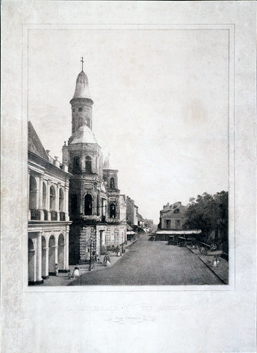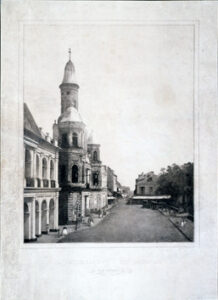Jules Lion
Jules Lion, a French-born mulatto, was a master lithographer and one of the most distinguished African American artists in antebellum New Orleans.

Courtesy of The Historic New Orleans Collection
La Cathedrale. Lion, Jules (Artist)
Jules Lion, a French-born mulatto, was one of the most distinguished African American artists in antebellum New Orleans. A master lithographer, he executed a series of portraits of Louisianans still reprinted today. In 1840, he introduced the daguerreotype process, the forerunner of photography, in New Orleans, only the second city in the United States (after New York City) to adopt this technology.
Relatively little is known about Lion’s early life. In Paris, he exhibited lithographs at the annual salons from 1831 to 1836; he also received prizes, published work inL’Artiste, and depicted famous Americans including Andrew Jackson and Martin Van Buren. In 1836 or early 1837, he immigrated to New Orleans, where he was hired for a new portrait lithography shop by the New Orleans Bee, a leading bilingual newspaper. With his brother Achille, a dentist who followed him from France, Jules Lion invested in imported retail goods and city real estate. The Panic of 1837 and the ensuing depression, however, forced the Lion brothers into lawsuits, property sales, and substantial financial losses.
In 1839 Jules Lion returned to France, where he encountered the revolutionary process recently introduced by Louis Jacques Mandé Daguerre. That fall, Lion was back in New Orleans, making daguerreian views of city landmarks, none of which are known to survive. By March 15, 1840, Lion had amassed enough daguerreotypes to mount an exhibition at the St. Charles Museum. The first to exhibit daguerreotypes in New Orleans, Lion received widespread newspaper coverage. Two years later, he began taking portraits of individuals and families.
By 1843, however, expensive equipment and fierce competition overcame his advantage in the photographic field and he returned to lithography. Besides working at his studio, he made two tours of southern Louisiana, producing portraits in Baton Rouge, Donaldsonville, Opelousas, and Assumption and St. James parishes. In the 1840s Lion also lithographed New Orleans scenes, including the 700 block of Canal Street and the colonial-era St. Louis Cathedral. He taught art, individually and in partnership with muralist Dominique Canova, at the Louisiana College (forerunner of the University of Louisiana), and at a night school for adults.
In 1860 Lion revived a project he began in the 1840s: bringing together a collection of his lithographic portraits and to publish in one volume, Notabilités de la Louisiane. Despite an impressive list of subscribers, he never raised enough money to publish the book. More than two hundred of the lithographs he produced from 1837 through 1847 are extant.
At the outbreak of the Civil War, Lion began to lithograph Confederate sheet music covers for New Orleans publishers, including subjects such as the Free Market and Jefferson Davis. After the federal occupation of the city. Lion returned to lithographic portraiture and teaching until his death January 9, 1866.
